Unit - 2
Semiconductors, Diode and Transistors
Q1) For a p-type Ge ni = 2.1x1019m-3 density of boron =3.2x1023 atoms m-3. The electron and hole mobility are 0.4 and 0.2 m2V-1s-1. Calculate conductivity before and after addition of boron?
A1) Before adding boron
 =q (p
=q (p p+n
p+n n)
n)
= ni q ( p+
p+ n) = 2.1x1019x1.6x10-19x(0.4+0.2)=2.016 S/m-1
n) = 2.1x1019x1.6x10-19x(0.4+0.2)=2.016 S/m-1
After adding boron
 =q p
=q p p
p
= 3.2x1023x1.6x10-19x0.2=10.24x103S/m-1
Q2) Determine the density of the donor atoms which have been added to the intrinsic Ge to make it a n-type material of resistivity 0.1x10-2ohm-m. Mobility of electron in n-type semiconductor is 0.5m2V-1s-1.
A2) =q (n
=q (n n)
n)
n=  /q
/q n
n
 = 1/
= 1/
n= 1/ q
q n = 1/(0.1x10-2x0.5x1.6x10-19) = 1.25x1022m-3
n = 1/(0.1x10-2x0.5x1.6x10-19) = 1.25x1022m-3
Q3) The intrinsic carrier density at room temperature in Ge is 3.4x1019m-3. If electron and hole mobilities are 0.4 and 0.2 m2V-1s-1 respectively. Calculate its resistivity?
A3) = 1/
= 1/
 =ni q (
=ni q ( p+
p+ n) = 3.4x1019x 1.6x10-19(0.4+0.2) = 3.264S/m-1
n) = 3.4x1019x 1.6x10-19(0.4+0.2) = 3.264S/m-1
 = 1/
= 1/ = 1/3.264 = 0.31ohm-m
= 1/3.264 = 0.31ohm-m
Q4) The electron and hole mobilities in In-Sb are 6 and 0.2 m2V-1s-1 respectively. At room temperature resistivity of In-Sb is 2x10-4ohm-m. Find intrinsic carrier concentration assuming the material to be intrinsic?
A4) = 1/
= 1/
 =ni q (
=ni q ( p+
p+ n)
n)
ni = 1/ q (
q ( p+
p+ n) = 1/2x10-4x1.6x10-19(6+0.2) = 5.04x1021m-3
n) = 1/2x10-4x1.6x10-19(6+0.2) = 5.04x1021m-3
Q5) An electric field of 90Vm-1 is applied to n-type semiconductor. Determine the current density in sample given electron mobility 0.4 m2V-1s-1, n=5.9x1020m-3?
A5) J= E
E
 = nq
= nq n = 5.9x1020x1.6x10-19x0.4=37.36S/m-1
n = 5.9x1020x1.6x10-19x0.4=37.36S/m-1
J=3.39x103
Q6) Determine the density of the donor atoms which have been added to the intrinsic Ge to make it a n-type material of resistivity 0.5x10-2ohm-m. Mobility of electron in n-type semiconductor is 0.8m2V-1s-1.
A6) =q (n
=q (n n)
n)
n=  /q
/q n
n
 = 1/
= 1/
n= 1/ q
q n = 1/(0.5x10-2x0.8x1.6x10-19) = 1.56x1021m-3
n = 1/(0.5x10-2x0.8x1.6x10-19) = 1.56x1021m-3
Q7) Calculate the drift current density in a semiconductor for a given electric field. For germanium sample at T=300oK where ND = 0 and NA =1x1015 cm-3 ni = 2.4x1013 cm-3. Assume electron and hole mobility to be 3900 cm2/V-sec and 1900 cm2/V-sec. Applied electric field is E= 40V/cm?
A7) As NA>>ND
p0 = ½ {(NA- ND) + (NA- ND)2+4ni2)1/2}
p0 = 5x1014cm-3
n= ni2/NA
n= 5.76x1011cm-3
J = q (p p+n
p+n n) E
n) E
For extrinsic p-type semiconductor
J = q NA p E =1.6x10-19x1900x1015x40 =12.16 A/cm2
p E =1.6x10-19x1900x1015x40 =12.16 A/cm2
Q8) The resistance of a wire is 20 Ω. What will be new resistance, if it is stretched uniformly 8 times its original length?
A8) R1 = 20 Ω, R2=?
Let the original length (l1) be l.
The new length, l2 = 8l1 (i.e) l2 =8l
The original resistance, R = ρ [ l1 / A1]
The new resistance
R2 = l2/A2 = (8l)/A2
Though the wire is stretched, its volume is unchanged.
Initial volume = Final volume
A1l1= A2l2 , A1l = A28l
A1 / A2 = 8l / l = 8
By dividing equation R2 by equation R1, we get
R2/R1 = (8l)/A2 A1/l
R2/R1 = A1/A2 8
Substituting the value of A1/A2, we get
R2 / R1 = 8 ×8 = 64 2
R2 = 64 × 20=1280 Ω
Hence, stretching the length of the wire has increased its resistance.
Q9) Consider a rectangular block of metal of height A, width B and length C as shown in the figure.
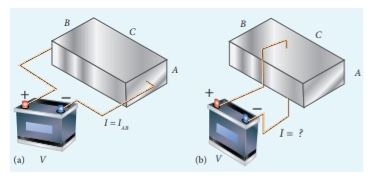
If a potential difference of V is applied between the two faces A and B of the block (figure (a)), the current IAB is observed. Find the current that flows if the same potential difference V is applied between the two faces B and C of the block (figure (b)). Give your answers in terms of IAB.
A9)
In the first case, the resistance of the block
RAB =  =
= 
The current IAB = V/RAB = V/ . AB/C (1)
In the second case, the resistance of the block RBC = A/BC
The current IBC = V/RBC = V/ . BC/A (2)
To express IBC interms of IAB, we multiply and divide equation (2) by AC, we get
IBC = V/ . BC/A . AC/AC = (V/ . AB/C) . C2/A2 = C2/A2 IAB
Since C > A, the current IBC > IAB
Q10) Compute the resistivity of the given material whose resistance is 2 Ω; area of cross-section and length are 25cm2 and 15 cm respectively?
A10)
Given
R = 2 Ω
l = 15 cm = 0.15 m
A = 25 cm2 = 0.25 m2
Resistivity formula is
= RA/l
= (20.25)/0.15 = 3.333 Ωm
Q11) The length and area of wire are given as 0.2 m and 0.5 m2 respectively. The resistance of that wire is 3 Ω, calculate the resistivity?
A11)
Given
R = 3 Ω
l = 0.2 m and
A = 0.5 m2
Resistivity formula is
= RA/l
= (3 0.5)/0.2 = 7.5 Ωm
Q12) Determine thermal equilibrium of electron and hole concentration for an n-type silicon semiconductor at T=300oK where ND = 1x1016cm-3 and NA =0. Assume ni = 1.5 x 1010cm-3?
A12) The majority carrier concentration
n0 = ½ {(ND- NA) + (ND- NA)2+4ni2)1/2}
n0 = 1016 cm-3
The minority carrier concentration
p0 = ni2/ND
p0 = 2.25x x104 cm-3
Q13) Determine thermal equilibrium of electron and hole concentration for doping concentration at T=300oK where ND = 4x1013cm-3 and NA =0. Assume ni = 2.4 x 1013cm-3?
A13) The majority carrier concentration
n0 = ½ {(ND- NA) + (ND- NA)2+4ni2)1/2}
n0 =3.12x1013 cm-3
The minority carrier concentration
p0 = ni2/ND
p0 = 1.45x x1013 cm-3
Q14) Determine thermal equilibrium of electron and hole concentration in n-type semiconductor at T=300oK where ND = 2x1016cm-3 and NA =12x1015 cm-3. Assume ni = 1.5 x 1010cm-3?
A14) The majority carrier concentration
n0 = ½ {(ND- NA) + (ND- NA)2+4ni2)1/2}
n0 =4x1015 cm-3
The minority carrier concentration
p0 = ni2/ND
p0 = 11.25x x103 cm-3
Q15) The intrinsic carrier density is 1.5 × 1016 m–3. If the mobility of electron and hole are 0.13 and 0.05 m2 V–1 s–1, calculate the conductivity.
A15)
ni = 1.5 1016 m-3
μe = 0.13 m2 V-1 s-1
μh = 0.05 m2 V-1 s-1
Conductivity σ = ni e (μe + μh)
σ = 1.5 1016 1.6 10-19 (0.13 + 0.05)
Conductivity σ = 4.32 10-4 Ω-1 m-1
Q16) The Intrinsic carrier density at room temperature in Ge is 2.37 × 1019 m3 if the electron and hole mobilities are 0.38 and 0.18 m2 V–1 s–1 respectively, calculate the resistivity.
A16)
ni = 2.37 1019 m3
μe = 0.38 m2 V-1 s-1
μh = 0.18 m2 V-1 s-1
Conductivity σ = ni e (μe + μh)
= 2.37 1019 1.6 10-19 (0.38 + 0.18)
= 2.1235 Ω-1 m-1
Resistivity = 1/σ
= 1/2.1235
Resistivity = 0.4709 Ωm
Q17) In a P-type germanium, ni = 2.1 × 1019 m–3density of boran 4.5 × 1023 atoms /m3. The electron and hole mobility are 0.4 and 0.2 m2 v–1 s–1 respectively. What is its conductivity before and after addition of boron atoms.
A17)
Given:
Intrinsic carrier concentration ni = 2.1 1019 m-3
Mobility of electrons μe = 0.4 m2v-1s-1
Mobility of holes μh = 0.2 m2v-1s-1
a) Conductivity before the addition of boron atoms
σ = ni e(μe + μh)
=2.1 1019 1.6 10-19(0.4 + 0.2)
= 2.016 Ω-1 m-1
b) Conductivity after the addition of boron atoms, Boron is a P-type impurity atom
σ = p e μh
= 4.5 1023 1.6 10-19 0.2
σ = 14400 Ω-1 m-1
Q18) For an intrinsic Semiconductor with a band gap of 0.7 eV, determine the position of EF at T = 300 K if m*h = 6m*e.
A18)
Bandgap Eg = 0.7 eV = 0.7 1.6 10-19 V
T = 300 K
Fermi energy for an intrinsic semiconductor
EF = Eg/2 + 3KT/4 log [m*h/m*e]
EF = 
=6.1563 10-20 Joules
EF = 
Fermi energy level EF = 0.3847 eV
Q19) Find the resistance of an intrinsic Ge rod 1 mm long, 1 mm wide and 1 mm thick at 300 K. The intrinsic carrier density 2.5 ×1019 m–3 is at 300 K and the mobility of electron and hole are 0.39 and 0.19 m2 v–1 s–1.
A19)
Length of Ge rod l = 1mm = 1 10-3 m
Breath b = 1 mm = 1 10-3 m
Thickness t = 1mm = 1 10-3 m
Intrinsic carrier concentration ni = 2.5 1019 m-3
Mobility of electron μe = 0.39 m2 v-1 s-1
Mobility of hole μh = 0.19 m2 v-1 s-1
a) Conductivity
σ = nie(μe + μh)
= 2.5 1019 1.6 10-19 (0.39 + 0.19)
σ = 2.32 Ω-1 m-1
b) Resistance
R = l/σA
=  (A = b t)
(A = b t)
R = 431 Ω
Q20) The intrinsic carrier density of a semiconductor is 2.1 × 1019 m–3. The electron and hole mobilities are 0.4 and 0.2 m2 V–1 s–1 respectively. Calculate the conductivity.
A20)
Given data:
Intrinsic carrier concentration ni = 2.1 1019 m-3
Mobility of electron μe = 0.4 m2V-1s-1
Mobility of hole μh = 0.2 m2V-1s-1
Conductivity σ = nie(μe + μh)
= 2.1 1019 1.6 10-19 (0.4 + 0.2)
Conductivity σ = 2.016 Ω-1m-1
Q21) Determine the values of VCC RC and RB of a fixed bias configuration for a given load line and defined Q point.
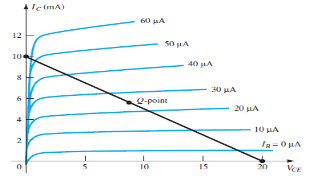
A21)
VCE = VCC = 20 V at IC = 0 mA
IC = VCC/RC at VCE = 0 V
RC = VCC/IC = 20 V/ 10 mA = 2kΩ
IB = (VCC – VBE)/RB
RB = (VCC – VBE)/IB = (20 V – 0.7 V)/25 μA = 772kΩ
Q22) A npn silicon transistor has VCC = 6 V and the collector load RC = 2.5 kΩ. Find: (i) The maximum collector current that can be allowed during the application of signal for faithful amplification. (ii) The minimum zero signal collector current required.
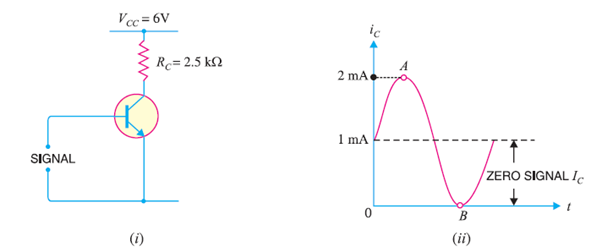
A22)
Collector supply voltage, VCC = 6 V
Collector load, RC = 2.5 Kω
(i) We know that for faithful amplification, VCE should not be less than 1V for silicon transistor.
∴ Max. Voltage allowed across RC = 6 − 1 = 5 V
∴ Max. Allowed collector current = 5 V/RC = 5 V/2.5 kΩ = 2 mA
Thus, the maximum collector current allowed during any part of the signal is 2 mA. If the collector current is allowed to rise above this value, VCE will fall below 1 V. Consequently, value of β will fall, resulting in unfaithful amplification.
(ii) During the negative peak of the signal, collector current can at the most be allowed to become zero. As the negative and positive half cycles of the signal are equal, therefore, the change in collector current due to these will also be equal but in opposite direction.
∴ Minimum zero signal collector current required = 2 mA/2 = 1 mA
During the positive peak of the signal [point A in Fig. 1(ii)], iC = 1 + 1 = 2mA
And during the negative peak (point B), iC = 1 − 1 = 0 mA
Q23) A transistor employs a 4 kΩ load and VCC = 13V. What is the maximum input signal if β = 100? Given Vknee = 1V and a change of 1V in VBE causes a change of 5mA in collector current.
A23)
Collector supply voltage, VCC = 13 V
Knee voltage, Vknee = 1 V
Collector load, RC = 4 kΩ
∴ Max. Allowed voltage across RC = 13 − 1 = 12 V
∴ Max. Allowed collector current, iC =12 V /RC = 12 V/ 4 KΩ = 3 mA
Maximum base current, iB = iC / β = 3 mA / 100 = 30 μA
Now collector-current / Base voltage (signal voltage) = 5 mA/V
∴Base voltage (signal voltage) = Collector current / (5 mA/V) = 3 mA /(5 mA/V) = 600 mV
Q24) Fig. (i) shows biasing with base resistor method. (i) Determine the collector current IC and collector-emitter voltage VCE. Neglect small base-emitter voltage. Given that β = 50. (ii) If RB in this circuit is changed to 50 kΩ, find the new operating point.
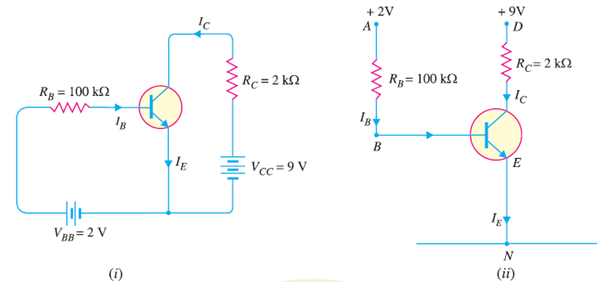
A24)
In the circuit shown in Fig. (i), biasing is provided by a battery VBB (= 2V) in the base circuit which is separate from the battery VCC (= 9V) used in the output circuit.
The same circuit is shown in a simplified way in Fig. (ii). Here, we need show only the supply voltages, + 2V and +9V. It may be noted that negative terminals of the power supplies are grounded to get a complete path of current.
IB RB + VBE = 2
IB = 20 A
A
IC =  IB = 50x20
IB = 50x20 A= 1mA
A= 1mA
IC RC + VCE = 9
VCE = 9- (1mA x 2000) = 7V
When RB is made equal to 50k
IC =  IB = 50x40
IB = 50x40 A= 2mA
A= 2mA
VCE = 9- (2mA x 2000) = 5V
So, the operating point is 5V and 2mA
Q25) Fig. (i) shows that a silicon transistor with β = 100 is biased by base resistor method. Draw the d.c. Load line and determine the operating point. What is the stability factor?
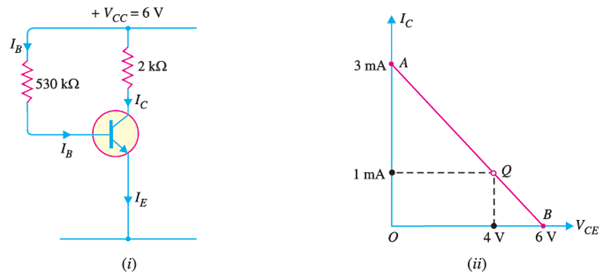
A25)
Here, VCC = 6 V, RB = 530 kΩ, RC = 2 kΩ
D.C. Load line
Referring to Fig. 3 (i), VCE = VCC − ICRC
When IC = 0,
VCE = VCC = 6 V. This locates the first point B (OB = 6V) of the load line on collector-emitter voltage axis as shown in Fig. (ii).
When VCE = 0,
IC = VCC/RC = 6V/2 kΩ = 3 mA.
This locates the second point A (OA = 3mA) of the load line on the collector current axis. By joining points A and B, d.c. Load line AB is constructed as shown in Fig. (ii).
Operating point Q
As it is a silicon transistor, therefore, VBE = 0.7V.
IB RB +VBE =VCC
IB = (6-0.7)/530x103 =10 A
A
IC =  IB = 100x10= 1mA
IB = 100x10= 1mA
VCE = 6- (1mA x 2000) = 4V
The operating point is 4V, 1mA.
The stability factor is given by  +1 = 100+1 =101
+1 = 100+1 =101
Q26) Design base resistor bias circuit for a CE amplifier such that operating point is VCE = 8V and IC = 2 mA. You are supplied with a fixed 15V d.c. Supply and a silicon transistor with β = 100. Take base-emitter voltage VBE = 0.6V. Calculate also the value of load resistance that would be employed.
Fig. Shows CE amplifier using base resistor method of biasing.
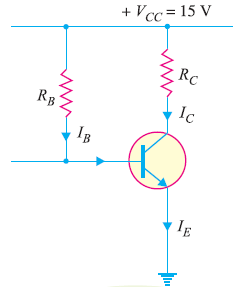
A26)
VCC = 15v
β = 100
VBE = 0.6V
VCE = 8V, IC = 2 mA.
VCC = VCE + IC RC
15 = 8+ 2mAxRC
RC = 3.5k
IC =  IB
IB
IB = 2/100 =0.02mA
VCC = IB RB + VBE
RB = (15-0.6)/ (0.02x10-3) = 720k
Q27) In base bias method, how Q-point is affected by changes in VBE and ICBO.
A27)
In addition to being affected by change in β, the Q-point is also affected by changes in VBE and ICBO in the base bias method.
(i) Effect of VBE:
The base-emitter-voltage VBE decreases with the increase in temperature (and vice-versa). The expression for IB in base bias method is given by;
IB = VCC – VBE/RB
It is clear that decrease in VBE increases IB. This will shift the Q-point (IC = βIB and VCE = VCC – IC RC). The effect of change in VBE is negligible if VCC >> VBE (VCC at least 10 times greater than VBE).
(ii) Effect of ICBO:
The reverse leakage current ICBO has the effect of decreasing the net base current and thus increasing the base voltage. It is because the flow of ICBO creates a voltage drop across RB that adds to the base voltage as shown in Fig. 6. Therefore, change in ICBO shifts the Q-point of the base bias circuit.

However, in modern transistors, ICBO is usually less than 100 nA and its effect on the bias is negligible if VBB >> ICBO RB.
Q28) For figure below is a resistor transistor circuit. The device has the characteristics as shown below. Find VCC, RC and RB?
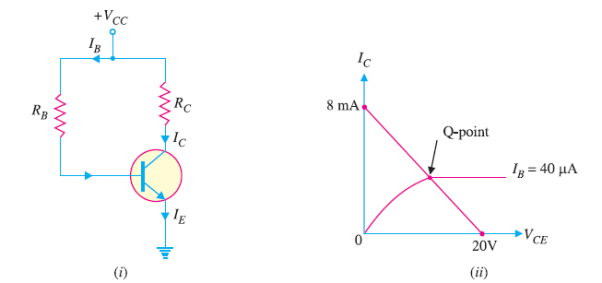
A28)
The DC Line voltage VCC = 20V
Maximum IC = VCC/RC
RC = 20/8x10-3=2.5k
IB = VCC – VBE/RB
RB = 20-0.7/40x10-6 = 482.5K
Q29) A 5.0V stabilized power supply is required to be produced from a 12V DC power supply input source. The maximum power rating PZ of the zener diode is 2W. Using the zener regulator circuit above calculate:
a). The maximum current flowing through the zener diode.
b). The minimum value of the series resistor, RS
c). The load current IL if a load resistor of 1kΩ is connected across the zener diode.
d). The zener current IZ at full load.
A29)
a). The maximum current flowing through the zener diode.
Maximum current = Watts/ Voltage =2W/5V =400mA
b). The minimum value of the series resistor, RS
 = 17.5 Ω
= 17.5 Ω
c). The load current IL if a load resistor of 1kΩ is connected across the zener diode.

d). The zener current IZ at full load.
Iz =Is -Il =440mA – 5mA = 395mA
Q30) In a CB IE= 2mA, IC=1.5mA. Calculate IB?
A30)
IE =IB+IC
2= IB+1.5
IB=0.5mA
Q31) In a CB current amplification factor is 0.9. If emitter current is 1.2mA. Determine the value of base current?
A31)
α = 0.9
IE =1.2mA
α = IC/ IE
IC = α IE =0.9 x 1.2 = 1.08mA
IE =IB+IC
1.2= IB+1.08
IB= 0.12mA
Q32) In a CB connection IC=1.0mA and IB= 0.02mA. Find the value of current amplification factor?
A32) IE =IB+IC =1+0.02 = 1.02mA
α = IC/ IE
α = 1.0/1.02 = 0.98
Q33) In a CB connection the emitter current is 0.98mA. If the emitter circuit is open the collector current becomes 40 A. Find total collector current. α =0.92
A. Find total collector current. α =0.92
A33) ICBO=40 A
A
IC =α IE+ICBO
= (0.92 x 0.98x10-3) + 40x10-6
IC =0.94mA
Q34) In a common base connection, α = 0.95. The voltage drop across 3 kΩ resistance which is connected in the collector is 2.5 V. Find the base current.
A34) IC = 2.5/3000 = 0.83mA
α = IC/ IE
IE = IC/α =0.83/0.95=0.87mA
IE =IB+IC
0.87 =IB+0.83
IB=0.04mA
Q35) Find the value of β if (i) α = 0.9 (ii) α = 0.98 (iii) α = 0.99.
A35)
 = α/1- α = 0.9/1-0.9 = 9
= α/1- α = 0.9/1-0.9 = 9
 = α/1- α = 0.98/1-0.98 = 49
= α/1- α = 0.98/1-0.98 = 49
 = α/1- α = 0.99/1-0.99 = 99
= α/1- α = 0.99/1-0.99 = 99
Q36) The collector leakage current in a transistor is 200 μA in CE arrangement. If now the transistor is connected in CB arrangement, what will be the leakage current? Given that β = 120.
A36) ICEO=200 μA
 = 120
= 120
α = /1+
/1+ = 120/121=0.99
= 120/121=0.99
ICEO=ICBO/1- α
ICBO= 1.6μA
Q37) For a certain transistor, IB = 18 μA; IC = 2 mA and β = 60. Calculate ICBO.
A37)
IC =  IB+ICEO
IB+ICEO
ICEO= IC -  IB= 2x10-3-(60x18x10-6) = 0.92mA
IB= 2x10-3-(60x18x10-6) = 0.92mA
α = /1+
/1+ = 60/61=0.98
= 60/61=0.98
ICBO= (1- α) ICEO = (1-0.98)x 0.92=15.08μA
Q38) Compare CB CE and CC configuration?
A38)
Parameters | Common-Emitter (CE) Amplifier | Common-Base (CB) Amplifier | Common-Collector (CC) Amplifier |
Input resistance | Moderate βre | Low re | High βRE |
Output resistance | High RC | High RC | Low re |
Voltage gain | High rL/re | High rL/re | About 1 |
Current gain | High β | Low, about 1 | High (1 + β) |
Power gain | High | Moderate | Low |
Phase shift | 180o | 0o | 0o |
Q39) Draw and explain input and output characteristics of CB configuration?
A39)
Input Characteristic Curve
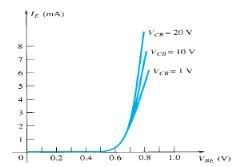
Fig: Input Characteristic Curve
- It is the relation between the input current IE to the input voltage VBE for various levels of output voltage VCB.
- It is also known as driving point characteristics.
Output Characteristic Curve

Fig: Output Characteristic Curve
- It is the relation between the output current IC to the output voltage VCB for various levels of input current IE.
- It is also known as collector set of characteristics.
- It has three basic regions:
- Active Region
Here, base-emitter junction is forward biased and collector-base junction is reverse biased.
As input current IE increases above zero, output current IC increases to a magnitude equal to IE as determined by the basic transistor current relationship.
So, the first approximation determined by the curve is
IC ≈ IE
2. Cut-off Region
It is defined as the region where the collector current IC is equal to 0A.
Here, the base-emitter junction and the collector-base junction both are in reverse bias.
3. Saturation Region
It is the region that lies towards the left of VCB = 0V.
Here, the base-emitter junction and the collector-base junction both are in forward bias.
Q40) Explain difference between avalanche and Zener breakdown?
A40)
Zener Breakdown | Avalanche Breakdown |
The process in which the electrons move across the barrier from the valence bond of p-type material to the conduction band of n-type material is known as Zener diode | The process of applying high voltage and increasing the free electrons or electric current in semiconductors and insulating materials is called an avalanche breakdown. |
This is observed in Zener diodes having a Zener breakdown voltage  | This is observed in Zener diode having a Zener breakdown voltage  |
The valence electrons are pulled into conduction due to the high electric field in the narrow depletion region. | The valence electrons are pushed to conduction due to the energy imparted by accelerated electrons, which gain their velocity due to their collision with other atoms. |
The increase in temperature decreases the breakdown voltage | The increase in temperature increase the breakdown voltage. |
The VI characteristic of a Zener breakdown has a sharp curve. | The VI characteristic curve of the avalanche breakdown is not as sharp as the Zener breakdown. |
It occurs in diodes that are highly doped | It occurs in diodes that are lightly doped. |
Q41) The MOSFET circuit shown below uses a MOSFET with the indicated characteristics. For each of the cases listed, solve MOSFET’s device current and drain voltage, and indicate whether the device is operating in saturation or triode. Given Kn = 250µA/ V2 VThN = 0.5V
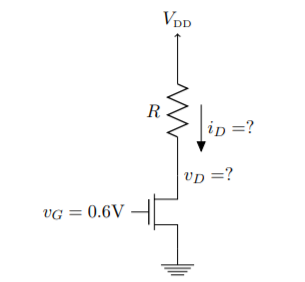
(A) R = 100Ω (B) R = 1kΩ (C) R = 10kΩ?
A41)
If the device is in saturation, then the device’s current and drain voltage are:
iD = ½ knv2OV
vD = VDD - iDR
Where vOV = vG− VTh = 0.1 V. If the device is in triode, then the solution is more complex:
iD = kn(vOVvD – ½ v2D)
vD = VDD - iDR
iD = kn(vOV(VDD – iDR) – ½ (VDD – iDR)2)
0 = Ai2D + BiD + C
Since the triode solution is more complex, it’s easier to first assume saturation and see if the result is consistent with that assumption. In saturation, the device current should always be 2.5 µA.
(A) R = 100Ω — In this case, we find
iD = 2.5 μA
vD = 4.999 75 V
This result is consistent with being in saturation since vD> vOV.
(B) R = 1kΩ — In this case, we find
iD = 2.5 μA
vD = 4.9975 V
This result is consistent with being in saturation since vD> vOV.
(C) R = 10kΩ— In this case, we find
iD = 2.5 μA
vD = 4.975 V
This result is consistent with being in saturation since vD> vOV.
Q42) The MOSFET circuit shown below uses a MOSFET with the indicated characteristics. For each of the cases listed, solve MOSFET’s device current and drain voltage, and indicate whether the device is operating in saturation or triode. Kn = 250µA/ V2 VThN = 0.5V
(A) R = 100Ω (B) R = 1kΩ (C) R = 10kΩ
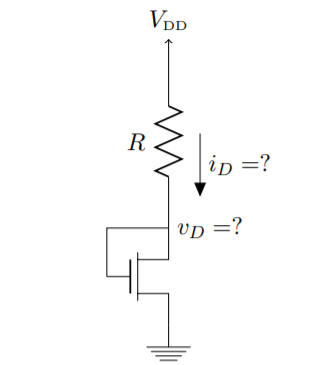
A42)
In this problem, the device is always in saturation due the diode connection, which guarantees vDS> vOV in all cases. The solution requires solving a quadratic
vOV = vD - VTh
iD = ½ knv2OV
vD = VDD - iDR
It is perhaps quickest to solve for vOV:
vOV = VDD – ½ kn Ev2OV - VTh
0 = ½ kn Rv2OV + vOV + (VTh – VDD)
Now we can use the quadratic formula to solve

vD = vD + VTh
iD = (VDD – vD)/R
In the numerator, we choose ‘+’ from the ‘±’ in order to obtain a positive-valued solution (a negative valued solution doesn’t make physical sense).
(A) R = 100Ω — In this case, we find
vOV = 4.27 V
vD = 4.77 V
iD = 2.28 mA
(B) R = 1kΩ — In this case, we find
vOV = 3.21 V
vD = 3.71 V
iD = 1.29 mA
(C) R = 10kΩ — In this case, we find
vov = 1.54 V
vD = 2.04 V
iD = 296 μA
Q43) The MOSFET circuit shown below uses a MOSFET with the indicated characteristics. For each of the cases listed, solve MOSFET’s device current and drain voltage, and indicate whether the device is operating in saturation or triode. Kn = 250µA/ V2 VThN = 0.5V. (A) R = 100Ω (B) R = 1kΩ (C) R = 10kΩ

A43)
In this problem, we can use the same procedure from Problem 1. Since RS is small, it should have a minor effect on the DC solution. We can evaluate that effect by iterating as follows:
Vs = 0 (initial assumption)
vov = vG – vS - VTh
iD = ½ knv2ov
vD = VDD - iDR
vS ← iDRS
If we initially assume vS = 0, then we can solve for a new vS, then repeat the equations until the results stabilizes. From this procedure, we find the following
vS = 3.09 mV
iD = 30.9 μA
vov = 4.97 V
As long as the device stays in saturation, these results should not depend on R and will be the same for each case. Then the solutions are:
(A) R = 100Ω
vD = 4.9969 V
vDS = 4.994 V > vov
saturation
(B) R = 1kΩ:
vD = 4.969 V
vDS = 4.966 V > vov
saturation
(C) R = 10kΩ
vD = 4.691 V
vDS = 4.688 V > vov
saturation
Q44) The MOSFET circuit shown below uses a pair of identical MOSFETs with the indicated characteristics. For each of the cases listed, solve MOSFETs’ device currents and drain voltages, and indicate whether each device is operating in saturation or triode. Kn = 250µA/ V2, VThN = 0.5V. (A) R = 100Ω (B) R = 1kΩ (C) R = 10kΩ.
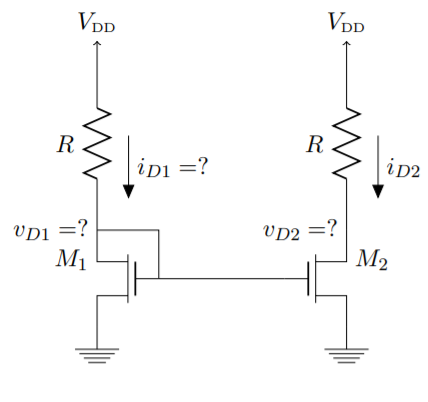
A44)
Notice that the left-hand side of this circuit is identical to the one in Problem 2. The solution should be exactly the same. On the right hand side, there is an identical MOSFET and an identical resistor. Furthermore, the two MOSFETs share identical gate and source voltages, and should therefore have identical currents (iD2 = iD1 in all cases). With all other things being equal, the only remaining unknown (vD2) should also be identical to its twin on the right-hand side. This is called a symmetry argument, and is a very useful method for analyzing current mirrors and differential circuits.